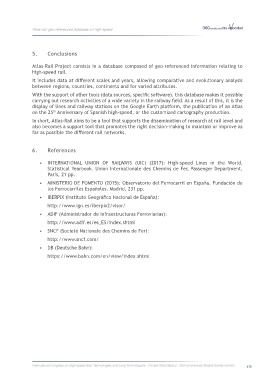Page 477 - 360.revista de Alta Velocidad - Nº 6
P. 477
Atlas-rail: geo-referenced database on high-speed
5. Conclusions
Atlas-Rail Project consists in a database composed of geo-referenced information relating to
high-speed rail.
It includes data at different scales and years, allowing comparative and evolutionary analysis
between regions, countries, continents and for varied attributes.
With the support of other tools (data sources, specific software), this database makes it possible
carrying out research activities of a wide variety in the railway field. As a result of this, it is the
display of lines and railway stations on the Google Earth platform, the publication of an Atlas
on the 25 Anniversary of Spanish high-speed, or the customized cartography production.
th
In short, Atlas-Rail aims to be a tool that supports the dissemination of research at rail level and
also becomes a support tool that promotes the right decision-making to maintain or improve as
far as possible the different rail networks.
6. References
• INTERNATIONAL UNION OF RAILWAYS (UIC) (2017): High-speed Lines in the World.
Statistical Yearbook. Union Internationale des Chemins de Fer, Passenger Department.
Paris, 21 pp.
• MINISTERIO DE FOMENTO (2015): Observatorio del Ferrocarril en España. Fundación de
los Ferrocarriles Españoles. Madrid, 231 pp.
• IBERPIX (Instituto Geográfico Nacional de España):
http://www.ign.es/iberpix2/visor/
• ADIF (Administrador de Infraestructuras Ferroviarias):
http://www.adif.es/es_ES/index.shtml
• SNCF (Societé Nationale des Chemins de Fer):
http://www.sncf.com/
• DB (Deutsche Bahn):
https://www.bahn.com/en/view/index.shtml
International Congress on High-speed Rail: Technologies and Long Term Impacts - Ciudad Real (Spain) - 25th anniversary Madrid-Sevilla corridor 475

